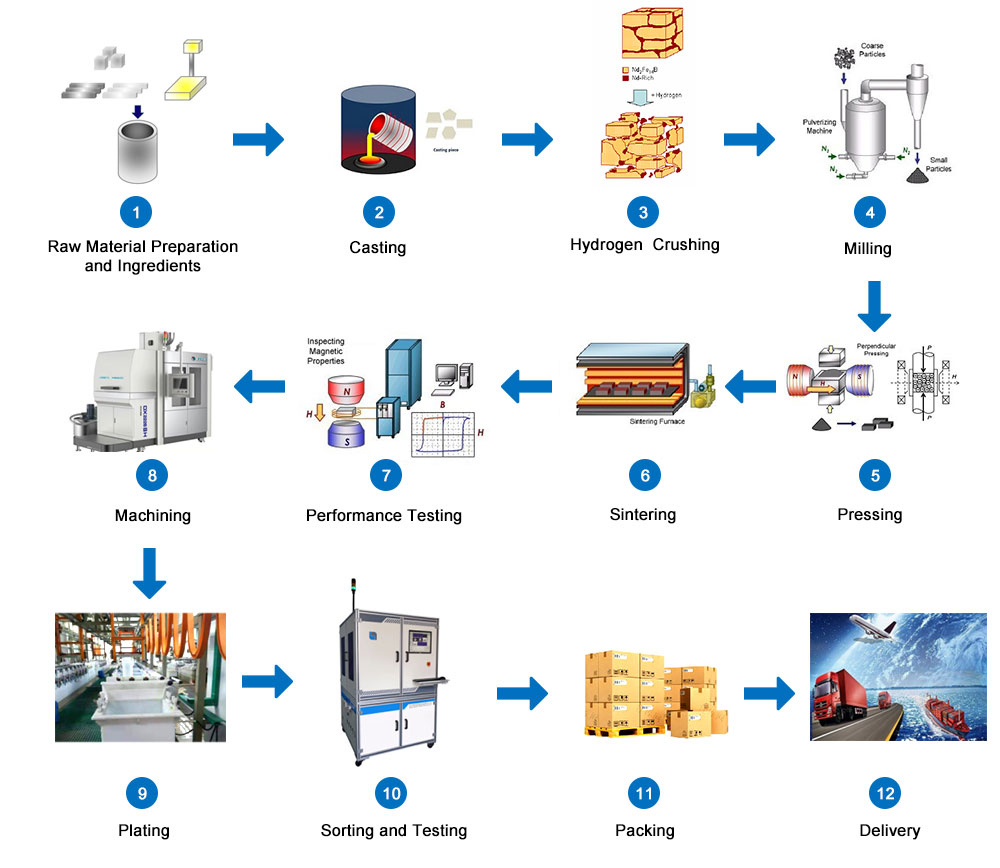First of all, the magnet is a ferromagnetic substance. If you want it to be magnetic, you must magnetize it, and if you want the magnetism to disappear, the plate must be demagnetized (demagnetized). Definition Magnetization refers to the process of obtaining magnetism from a substance that does not originally have magnetism. Principle The magnetic material is divided into many tiny regions. Each tiny region is called a magnetic domain, and each magnetic domain has its own magnetic distance (that is, a tiny magnetic field). Under normal circumstances, the direction of the magnetic pitch of each magnetic domain is different, and the magnetic fields cancel each other out, so the entire material does not show magnetism to the outside. When the direction of each magnetic domain tends to be the same, the whole piece of material shows magnetism to the outside.
The so-called magnetization is to make the magnetic pitch direction of the magnetic domains in the magnetic material become consistent. When a material that is not magnetic to the outside is placed in another strong magnetic field, it will be magnetized. However, not all materials can be magnetized, only a few metals and metal compounds can be magnetized. On the contrary, demagnetization: When the magnetized material is affected by external energy, such as heating and impact, the magnetic pitch direction of each magnetic domain in it will become inconsistent, and the magnetism will weaken or disappear. This process is called demagnetization. Generally speaking, magnetism refers to ferromagnetism, which is a kind of magnetism possessed by magnets. In addition to metallic iron, it also includes metallic nickel, cobalt, some rare earth metals, and some oxides and compounds of these metals. Magnetism in physics also includes paramagnetism, diamagnetism, and antiferromagnetism. There are mostly paramagnetic and diamagnetic substances in nature, so magnets become very peculiar.

There are many external factors that affect the magnetic properties of magnetic materials, of which temperature and frequency are the most important.
(1) Temperature. Temperature has a particularly significant effect on the magnetic properties of magnetic materials. Generally, the permeability and saturation magnetic induction of metallic magnetic materials decrease with the increase of temperature. When the temperature exceeds a certain value, the magnetic material will lose its magnetism and become a paramagnetic substance. Since sintered NdFeB has a negative temperature coefficient, the instantaneous maximum temperature and the continuous maximum temperature of the use environment will produce different degrees of demagnetization on the magnet itself, including reversible and irreversible, recoverable and unrecoverable.
(2) Frequency. The change of frequency also has a certain influence on the magnetic performance. The increase in frequency will reduce the magnetic permeability of the material and increase the core loss.
In addition, the magnetic properties of magnetic materials not only depend on their chemical composition, but also related to mechanical processing methods and heat treatment conditions. When the metal magnetic material is mechanically processed, internal stress will be generated, which can reduce the magnetic permeability of the material, increase the coercive force and increase the loss. In order to eliminate stress and restore magnetism, annealing treatment is necessary.
(3) Environmental humidity: NdFeB itself is easy to corrode and oxidize. Generally, we adopt surface treatment to protect the permanent magnet, but it cannot fundamentally solve the influence of environmental humidity on the magnet. The drier the environment, the longer the service life of the magnet.


 sales00@jlmagnet.com
sales00@jlmagnet.com






